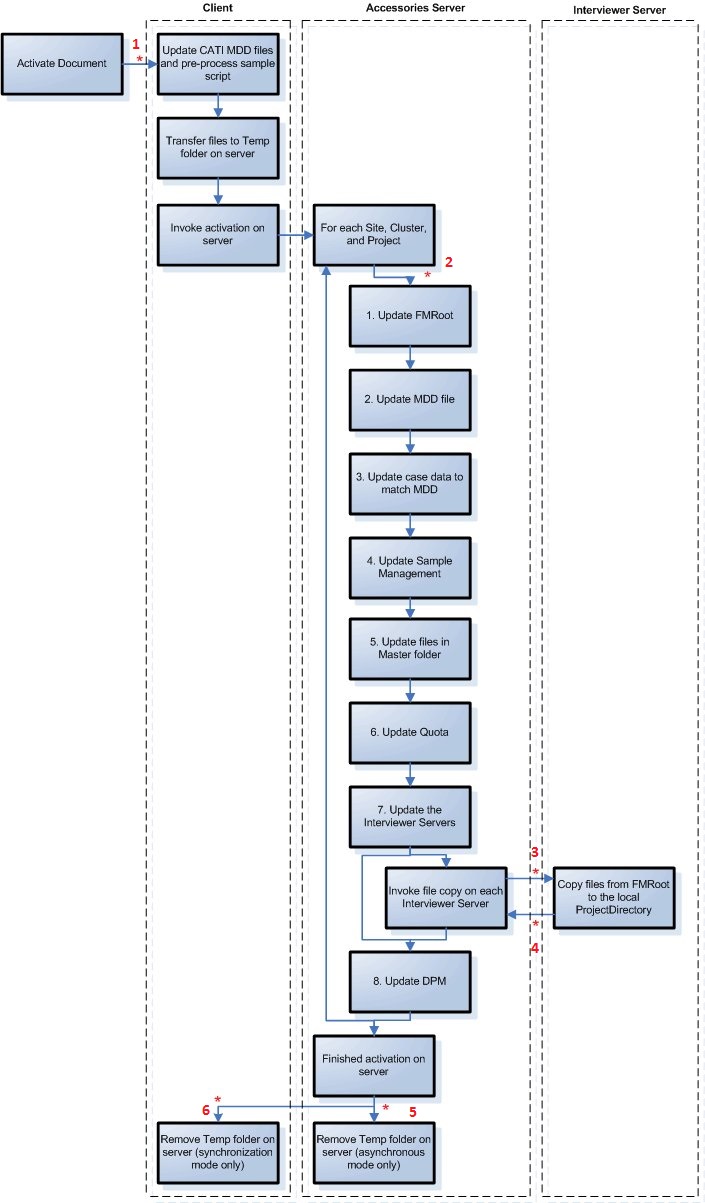Activation
The following options are available for project activation:
▪Enforce company-specific project rules prior by validating the .mdd file prior to activation.
▪Manipulate the .mdd file, images, templates, or other related files prior to activation. For example, you can retrieve images from a central repository and convert them to an appropriate size.
▪After activation, cleanup the temporary data that was created prior to activation.
▪Send notifications by updating a RSS feeds, updating social media sites when a project is available, or informing third-party systems.
Activation component flowchart
This diagrams is an overview of the activation process: it shows the components that are involved in the activation process.
The red asterisks indicate areas where additional processing can occur:
1 On the client before starting activation (OnBeforeClientActivate).
2 On the Accessories Server before activating a particular project on a particular cluster and site. (OnAfterClientActivate)
3 On the Interviewer Server before copying the project files from FMRoot to the local Project cache directory. (OnBeforeSiteActivateProject)
4 On the Interviewer Server after copying the project files from FMRoot to the local Project cache directory . (OnAfterSiteActivateProject)
5 On the Accessories Server after activating a particular project. (OnBeforeEngineActivateProject)
6 On the client after activation is complete, but only if the activation was run synchronously (that is, if it was not added to the activation queue). (OnAfterEngineActivateProject)
mrScriptBasic scripts that contain the following functions can be run during the aforementioned processing points:
OnBeforeClientActivate(ActivateDocument)
Executed on the activation client computer, the Interviewer Server Administration Launch activity, or the server that initiates project promotion.
OnAfterClientActivate(ActivateDocument)
Executed on the Accessories Server that performs the activation.
OnBeforeSiteActivateProject(ActivateDocument, SiteName, ClusterName, ProjectName)
Executed on the Interviewer Server when copying files.
OnAfterSiteActivateProject(ActivateDocument, SiteName, ClusterName, ProjectName)
Executed on the Interviewer Server when copying files.
OnBeforeEngineActivateProject(Site, Project)
Executed on the Accessories Server that performs the activation.
OnAfterEngineActivateProject(Site, Project)
Executed on the activation client computer, the Interviewer Server Administration Launch activity, or the server that initiates project promotion.
The functions are called during activation when they are present in an mrScriptBasic script.
In the case of client-to-server activation, the mrScriptBasic script is run on the client computer that initiates the activation as well as on the server to which the project is activated. When the project is activated to multiple sites, the script runs on the same accessories server but the event handler function is invoked for each site.
In the case of a site-to-site activation (Promote Project), the client is the computer that initiates the activation and the server is the computer to which the project is activated. The activation type can be determined from the ActivateDocument.ActivateSettings.Sites[].Clusters[].Projects[].ActivateFromDpmServerproperty. When the property is set to True, then the activation is treated as a site-to-site activation. For site-to-site activations only the server functions on the destination cluster are executed. The client functions are executed as they are only designed to be run from a true client computer (not the source cluster). Any functions that are missing from the script are silently ignored.
The
ActivationSettings.config.xml file stores activation configuration settings, effectively bypassing the need to query the configuration settings from DPM. For more information, see
ActivationSettings.config.xml.
See
See also

